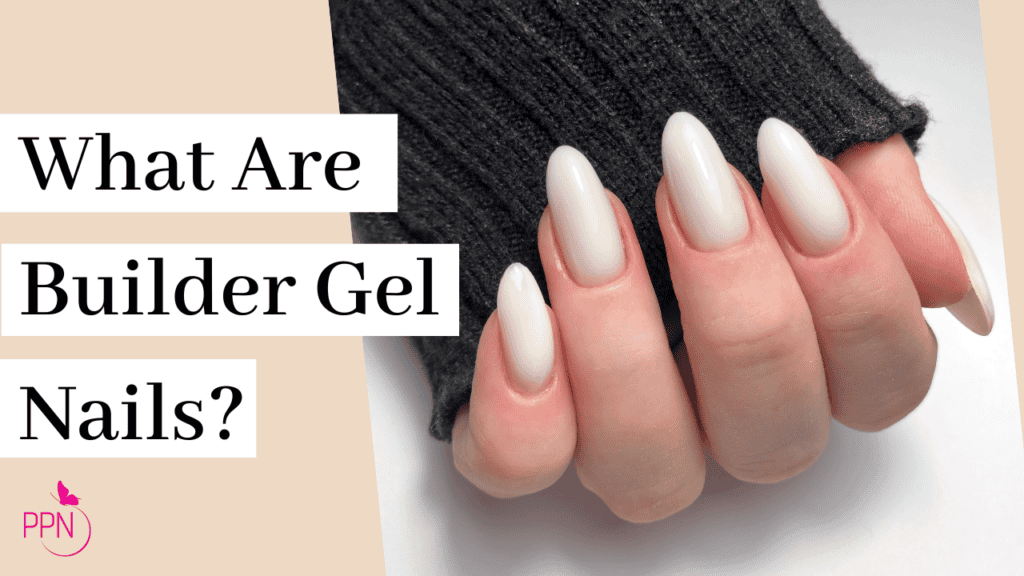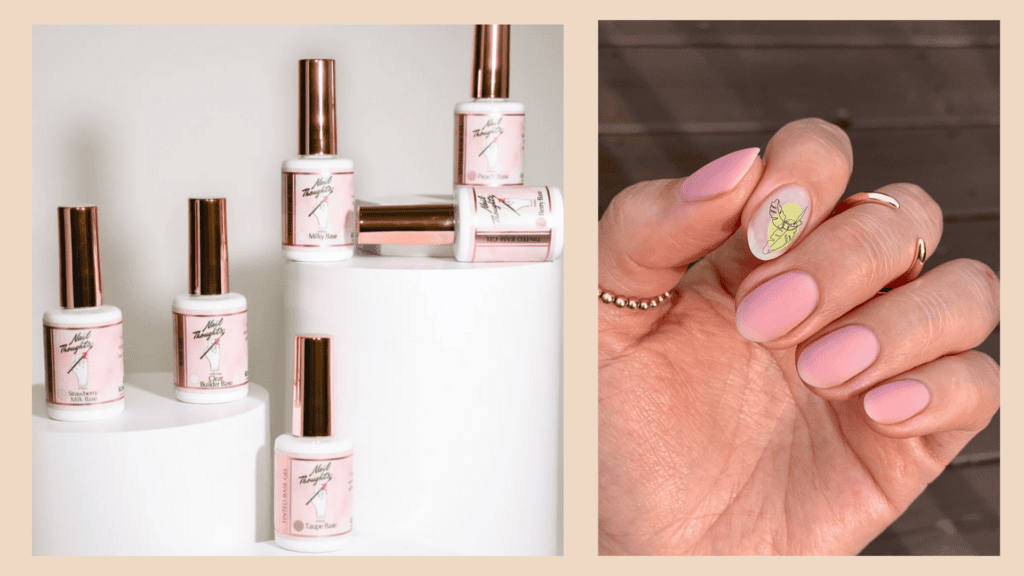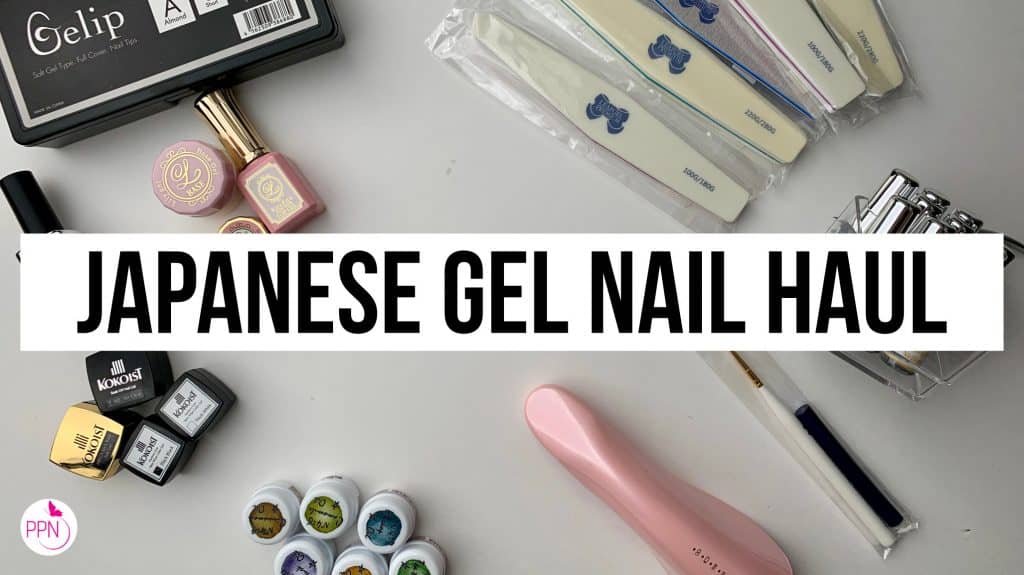If you’re calling your natural nail overlays builder gel nails all the time because that is what social media has taught you. Stop… at least until you watch this video.
Now, before we get started, I want to let you know of a wonderful resource I created to help you identify any nail gel in the market. It’s an eBook I put together simply called Nail Gels 101 and it’s completely free. It will help you further understand gels, beyond this post.
To grab your copy, click HERE, tell us where to send it, and it should be in your inbox relatively soon thereafter.

What is builder gel?
Builder gel is a nail gel that is used on the nails to give them some level of structure.
This structure that you give the nails can be over natural nails or extensions.
Anything that is not a gel polish formula, like Gelish Gel Polish or Shellac Gel Polish, is technically a builder gel.
Let me say it differently… Any nail gel system that operates with a foundation gel that has viscosity to it, is a builder gel nail system. So we’re talking viscosity in gel, that is what a builder gel is.
And it is the foundation gels, the gels that you use on the nails for adhesion and structure that are the builder gels. The gels that you want to build the nail up with for strength and to fill in imperfections.
Builder gel can be hard or soft gel, and these two categories are what we really should be using to classify nail gel.
Hard gel is typically more viscous and cannot soak off in acetone, soft gel is often less viscous and can be soaked off in acetone.
Hard gels and soft gels apply, wear, and remove very differently from one another, and that is why these are the categories we should be using to define our gel nail products.
In fact, remember how I just said that it is the foundation gels that are the builder gel? Well actually hard gel colors have some viscosity to them, and so do their topcoats. So if you’re using a true hard gel system from base coat to topcoat, there could be some level of build component throughout the entire system. In the base, color, and top gels.
Which is why again, we need to use the terms hard gel or soft gel to define our builder gel. The words builder gel alone don’t give us the whole story.
Builder gels can be found in pots or bottles.
Almost always, a hard gel builder product is going to be found in a pot vs a bottle and that is because as I already mentioned, hard gel tends to be more viscous than soft gel. And within hard gel viscosities gels can get pretty solid. This viscosity does not favor the product being dispensed from a bottle which is why 99% of the time you will find hard gel, in a pot vs a bottle, with the exception of top coats. Hard gel top coats can be commonly found in bottles.
Now soft gel is a tad different. Soft gel is often found in a bottle but it has viscosities ranging from thin up to thick enough not to fit in a bottle but rather in a pot. Potted soft gel is actually such a secret weapon, at least it has been in my arsenal of tools for creating beautiful structured overlays. And the reason for this is because it sort of has the strength of hard gel, but with the lightweight and natural feel of soft gel.
Applying builder out of a pot takes a bit more skill, but the result can be beautiful and most importantly very long wearing. Take a look at this set I did using Kokoist Excel Builder, a potted soft gel builder. (Code PPN10 saves you 10%).
After nearly 10 years of using this brand it is still among my favorites.

This is one of the reasons why I have specialized in structure soft gel systems like Japanese Gel, for a decade now. Because I can overlay any nail length with it including extensions.
Builder gel has a list of other trendy names like BIAB (which is an acronym for builder in a bottle), structure gel, and rubber base gel, but again these terms don’t actually tell us if a gel is a hard or a soft gel.
Bottled builders are a lot more beginner friendly, for a couple of reasons. First, they have a thinner viscosity allowing them to flow into place with just a bit of technique, and two, because their bottle and brush mechanism is something we have been used to for years! Since children essentially, painting our nails.
There is currently only one bottled builder I’ve ever really used (for the last 5 years almost now!), and these are Nail Thoughts by KOKOIST. They are base and builder, and base/builder/color when you opt for a tinted option. These gels are also made in Japan, and like most Japanese gels require no additional products to prep the nails like pH balancer or bonder, as mostly all nail systems do.
I like to use these when I am in a pinch and need to save time doing my nails, or when I’m wearing short to medium length nails.
The clear option is an essential, but Milky White Base and Peach Base (featured in the nail set below) are staples. See them all here.
(You can also save 10% off of these, with code PPN10)

The last thing you should know is that all builder gel, hard gel or soft gel, can be filled. Meaning it doesn’t have to come off completely if you will be reapplying it.
One advantage of soft gel is in the removal process. You can file soft gel builder very thin and then soak it in acetone to remove it. To remove hard gel, you also file it down thin, but you will have to leave it on the nails until it grows out, as hard gel does not soak off in acetone.
Both hard gel and soft gel builders have their role in the industry. I personally like to reserve hard gel as the go-to for overlaying longer natural nails and extensions,
and soft gel for enhancing the look and feel of the natural nails, and natural-length extensions.
To recap. Builder gel nails are nails that are overlaid with a structure gel with viscosity. The gel is either a hard gel or soft gel, the words “builder gel” alone do not tell us what kind of gel it is.
I hope you enjoyed this builder gel exposé, and I’ll see you next week. Bye for now!

Content written by Paola Ponce.
Paola Ponce is a licensed nail tech of 10+ years and a certified Japanese gel nail educator.
Learn more about her journey as a specialized gel nail artist and her gel nail application course inside her free masterclass here.
These blogs are copyrighted material, and any use of this blog is not permitted without written concern first. Some of these blogs contain affiliate links that give us a small commission when qualifying purchases are made. Thank you for being so supportive, which helps us to continue creating valuable resources and content like this.


![[[ Nail Thoughts X Kokoist ]] Bottled Gel Launch | All COLORS SWATCHED](https://paolaponcenails.com/wp-content/uploads/2020/11/ntswatchesnewthumb-1024x575.jpg)